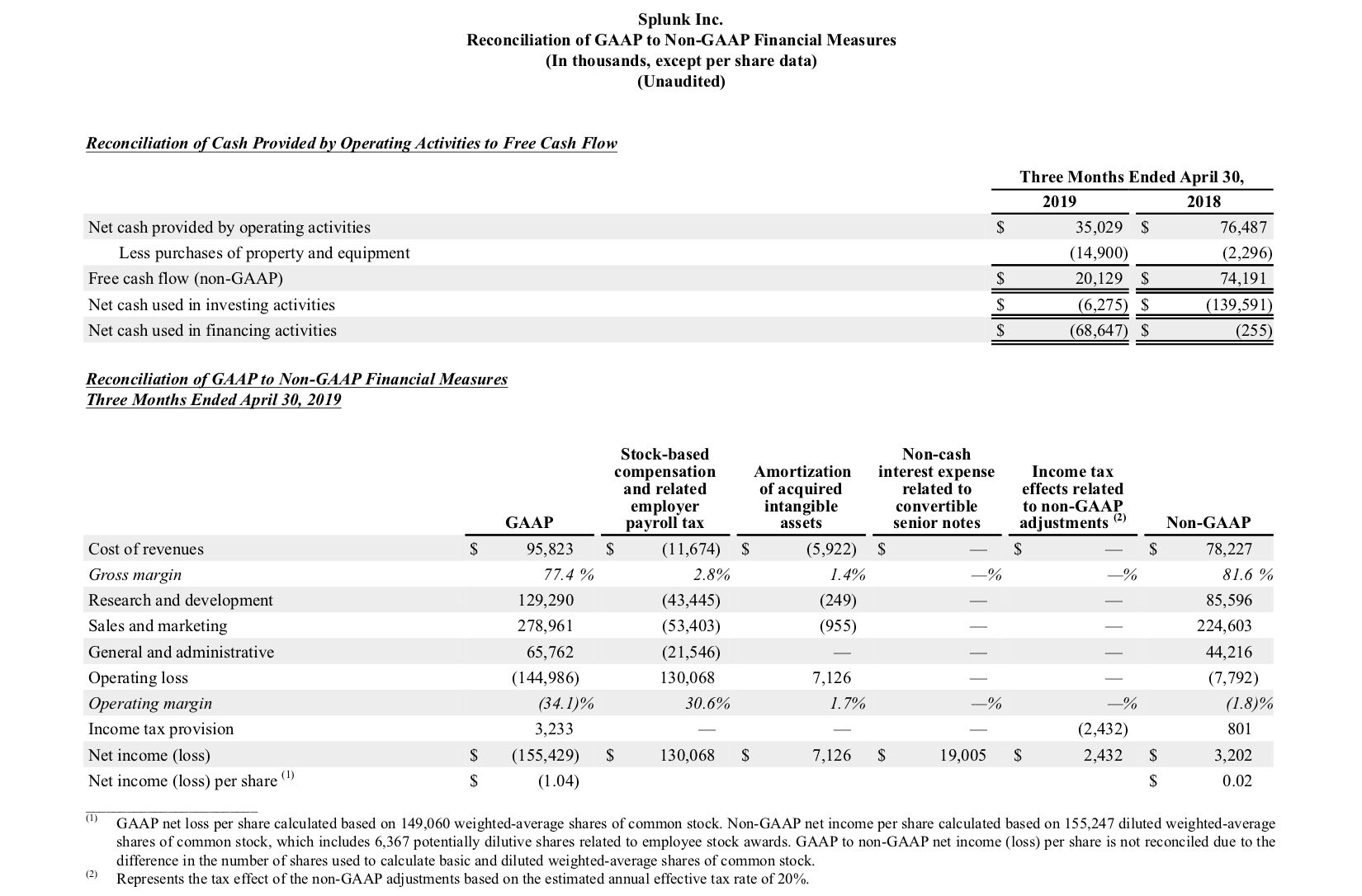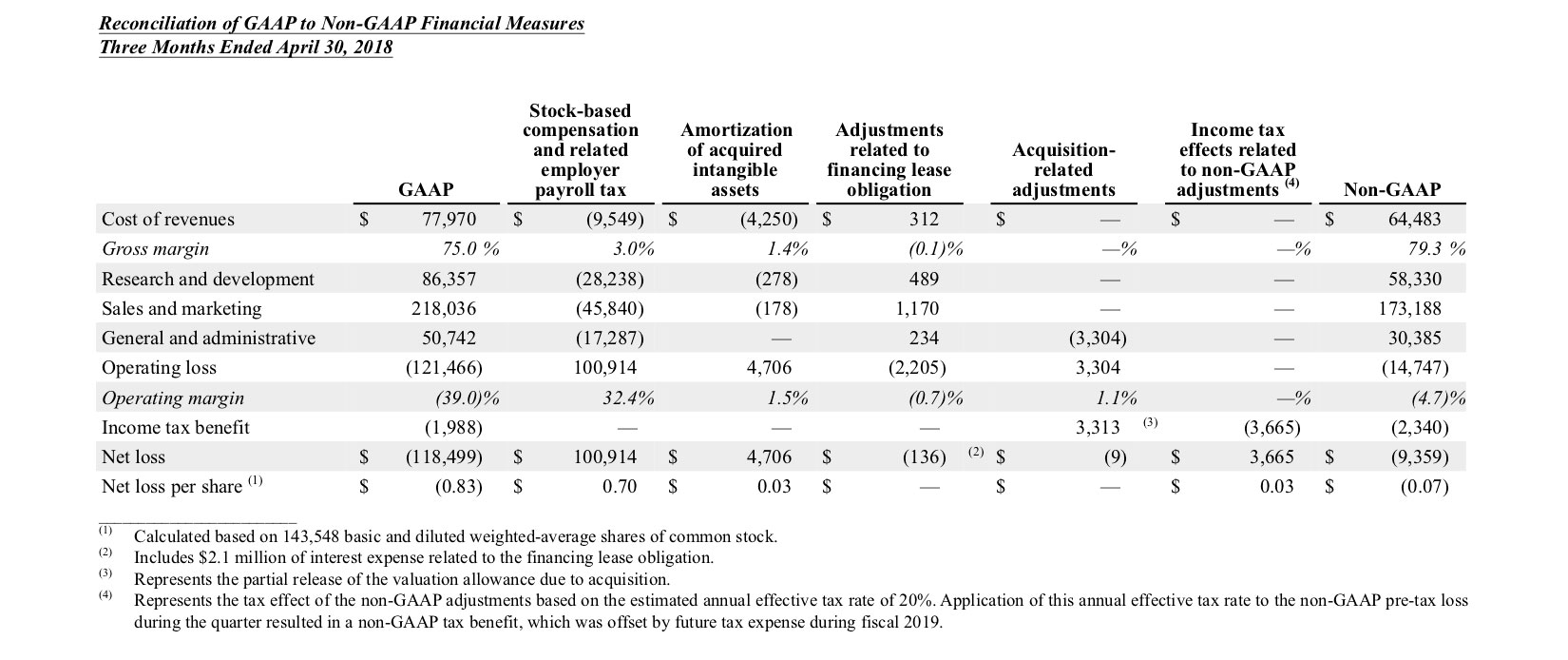SAN FRANCISCO – May 23, 2019 – Splunk Inc. (NASDAQ: SPLK), delivering actions and outcomes from the world of data, today announced results for its fiscal first quarter ended April 30, 2019.
First Quarter 2020 Financial Highlights
- Software revenues were $265 million, up 54% year-over-year.
- Total revenues were $425 million, up 36% year-over-year.
- GAAP operating loss was $145 million; GAAP operating margin was negative 34.1%.
- Non-GAAP operating loss was $7.8 million; non-GAAP operating margin was negative 1.8%.
- GAAP loss per share was $1.04; non-GAAP income per share was $0.02.
- Operating cash flow was $35.0 million with free cash flow of $20.1 million.
“Our customers are successful because they can unlock value from their growing data landscapes with the unique Splunk platform, and this is what fuels our strong performance,” said Doug Merritt, President and CEO, Splunk. “In Q1, we released Splunk Connected Experiences and Splunk Business Flow, new products that are part of our vision to take Splunk beyond IT and security and to bring our customers closer to their data. These products further differentiate Splunk as we strive to bring data to every question, every decision and every outcome for any organization.”
Business Highlights:
Customers:
- Signed more than 400 new enterprise customers.
- New and Expansion Customers Include: Brink’s, Cerner Corporation, Chipotle, City University of Hong Kong, El Corte Inglés (Spain), Entertainment One (Canada), LATAM Airlines Group (Chile), PCL Construction, Slack, SumTotal Systems, University of Alabama at Birmingham Health System, Vancouver City Savings Credit Union (Canada) and West Bend Mutual Insurance.
Corporate:
- New Innovations Bring Customers Closer to Their Data: Splunk unveiled a wide range of new technologies including Splunk® Connected Experiences, which helps customers bring the power of data where they need it through augmented reality, Splunk Mobile and Splunk TV. Splunk Business Flow expands Splunk’s reach, enabling business operations professionals to quickly discover bottlenecks that threaten business performance and identify opportunities for improvement. Splunk also unveiled new versions of Splunk ITSI, Splunk ES, Splunk UBA, Splunk Phantom and Splunk App for Infrastructure.
- Research Reveals Data Opportunity: Splunk released a new research report, The State of Dark Data, which found that, on average, business and IT decision makers estimate that 55 percent of their data is dark (unknown or untapped) despite widespread belief that such data is highly valuable and drives meaningful business outcomes. The report also explored how automation via AI and machine learning is believed to impact the future of jobs, and how the data opportunity is impacting career growth.
- Employee Success Celebrated Around the Globe: Splunk was recognized for being a great place to work around the world: LinkedIn, the San Francisco Business Times, Great Place to Work Asia and Washingtonian all named Splunk as a top employer. Splunk is committed to celebrating and empowering employees to build an inclusive culture.
- Executive and Board Appointments: The company celebrated two new additions to its executive team: Jason Child as Chief Financial Officer and Carrie Palin as Chief Marketing Officer. Splunk also announced the appointment of Board member Graham Smith, former CFO at Salesforce, as the Chairman of the Board of Directors, and welcomed Atlassian CTO Sri Viswanath to the Board.
- Global Partner Summit: The company deepened relationships with strategic partners and announced a host of new updates that make it easier than ever for partners to be successful with Splunk at Global Partner Summit.
Financial Outlook
The company is providing the following guidance for its fiscal second quarter 2020 (ending July 31, 2019):
- Total revenues are expected to be approximately $485 million.
- Non-GAAP operating margin is expected to be approximately 3%.
The company is updating its previous guidance provided on February 28, 2019 for its fiscal year 2020 (ending January 31, 2020) as follows:
- Total revenues are expected to be approximately $2.25 billion (was approximately $2.20 billion).
- Non-GAAP operating margin is expected to be approximately 14% (unchanged from previous guidance).
All forward-looking non-GAAP financial measures contained in this section “Financial Outlook” exclude estimates for stock-based compensation and related employer payroll tax, and amortization of acquired intangible assets.
A reconciliation of non-GAAP guidance measures to corresponding GAAP measures is not available on a forward-looking basis without unreasonable effort due to the uncertainty regarding, and the potential variability of, many of these costs and expenses that may be incurred in the future. The company has provided a reconciliation of GAAP to non-GAAP financial measures in the financial statement tables for its fiscal first quarter 2020 non-GAAP results included in this press release.
Conference Call and Webcast
Splunk’s executive management team will host a conference call today beginning at 1:30 p.m. PT (4:30 p.m. ET) to discuss the company’s financial results and business highlights. Interested parties may access the call by dialing (866) 501-1535. International parties may access the call by dialing (216) 672-5582. A live audio webcast of the conference call will be available through Splunk’s Investor Relations website at http://investors.splunk.com/events-presentations. A replay of the call will be available through May 30, 2019 by dialing (855) 859-2056 and referencing Conference ID 1946609.
Safe Harbor Statement
This press release contains forward-looking statements that involve risks and uncertainties, including statements regarding Splunk’s revenue and non-GAAP operating margin targets for the company’s fiscal second quarter and fiscal year 2020 in the paragraphs under “Financial Outlook” above and other statements regarding Splunk’s new products, innovations and product development, Splunk’s market opportunity, future growth, current momentum, strategy, expectations for Splunk’s industry and business, customer demand and penetration, Splunk’s partner relationships, customer success and expanding use of Splunk by customers. There are a significant number of factors that could cause actual results to differ materially from statements made in this press release, including: risks associated with Splunk’s rapid growth, particularly outside of the United States; Splunk’s inability to realize value from its significant investments in its business, including product and service innovations and through acquisitions; Splunk’s shift from sales of perpetual licenses in favor of sales of term licenses and subscription agreements for our cloud services; Splunk’s transition to a multi-product software and services business; Splunk’s inability to successfully integrate acquired businesses and technologies; Splunk’s inability to service its debt obligations or other adverse effects related to Splunk’s convertible notes; and general market, political, economic, business and competitive market conditions.
Additional information on potential factors that could affect Splunk’s financial results is included in Splunk’s Annual Report on Form 10-K for the fiscal year ended January 31, 2019, which is on file with the U.S. Securities and Exchange Commission (“SEC”) and Splunk’s other filings with the SEC. Splunk does not assume any obligation to update the forward-looking statements provided to reflect events that occur or circumstances that exist after the date on which they were made.
About Splunk Inc.
Splunk Inc. (NASDAQ: SPLK) helps organizations ask questions, get answers, take actions and achieve business outcomes from their data. Organizations use market-leading Splunk solutions with machine learning to monitor, investigate and act on all forms of business, IT, security, and Internet of Things data. Join millions of passionate users and try Splunk for free today.
Splunk, Splunk>, Listen to Your Data, The Engine for Machine Data, Splunk Cloud, Splunk Light and SPL are trademarks and registered trademarks of Splunk Inc. in the United States and other countries. All other brand names, product names, or trademarks belong to their respective owners. © 2019 Splunk Inc. All rights reserved.
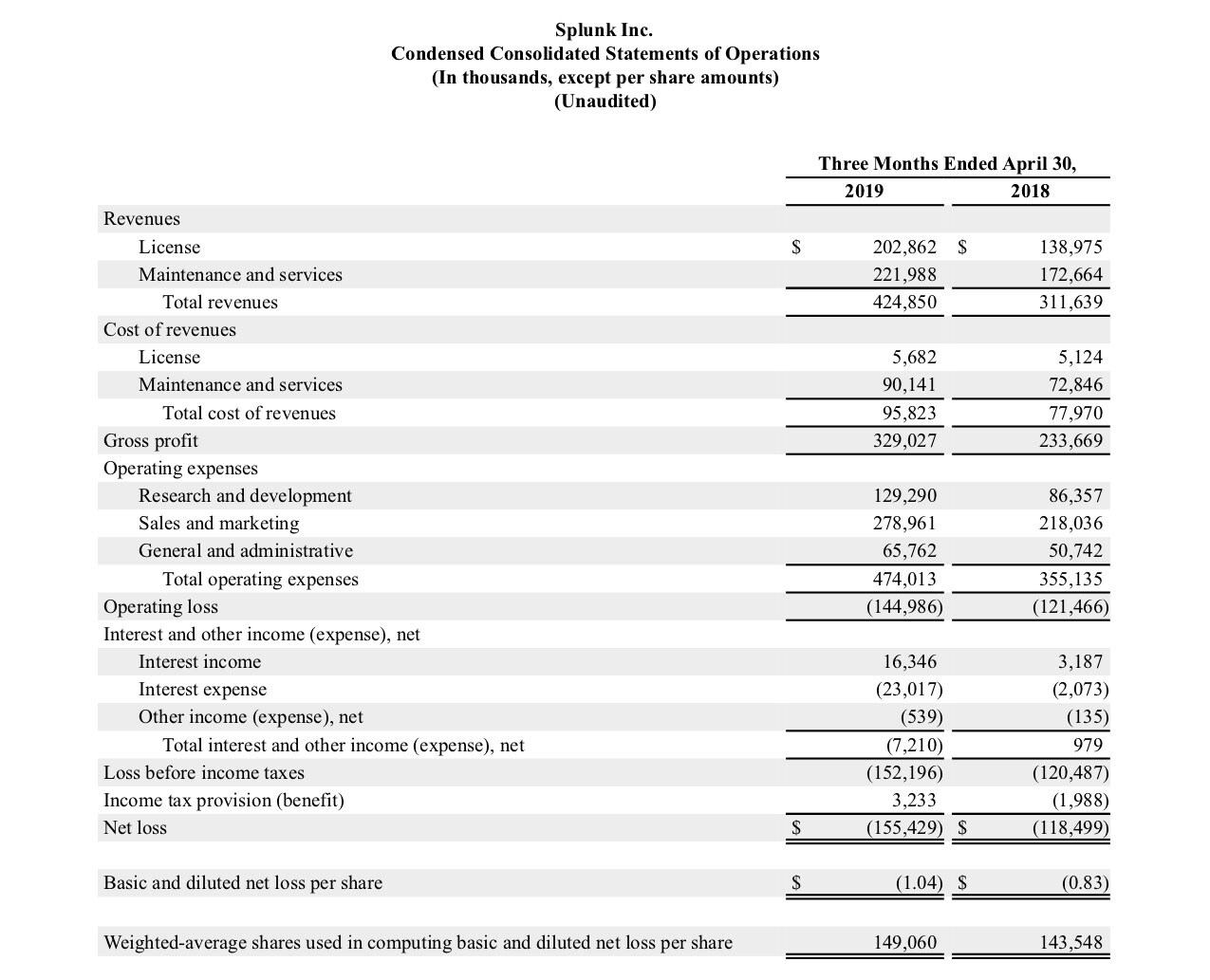
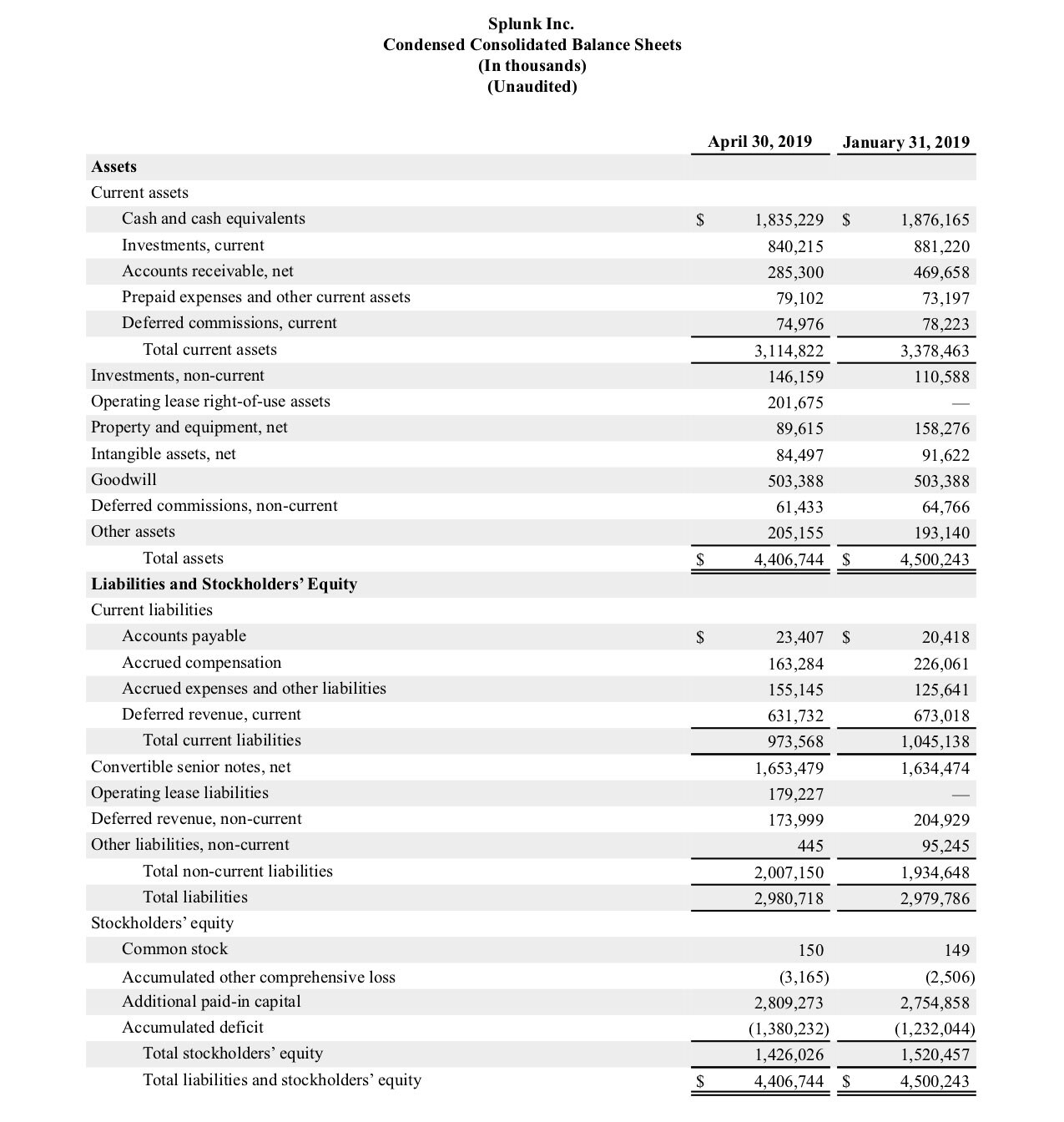
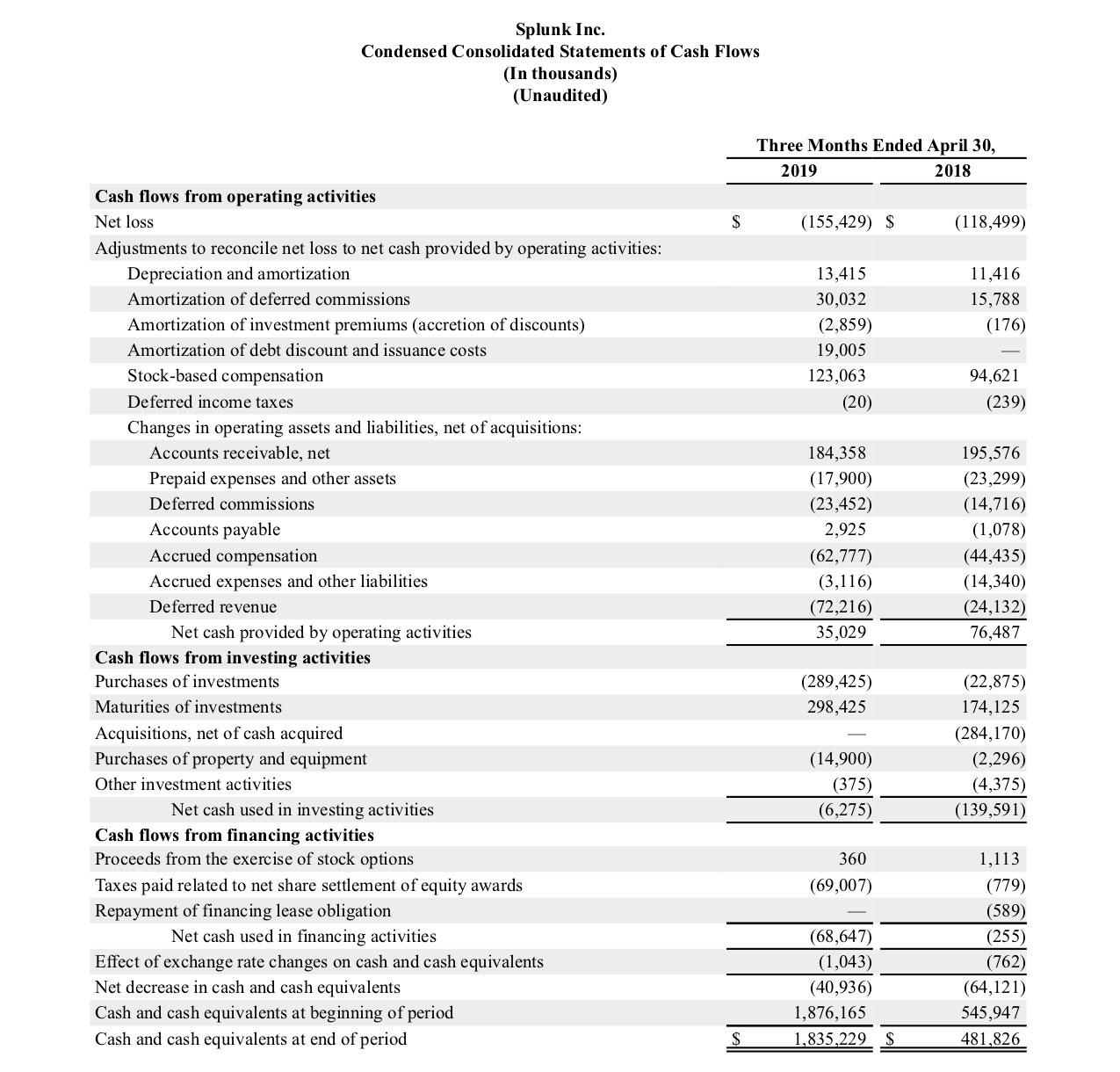
SPLUNK INC.
Non-GAAP financial measures and reconciliations
To supplement Splunk’s condensed consolidated financial statements, which are prepared and presented in accordance with generally accepted accounting principles in the United States (“GAAP”), Splunk provides investors with certain non-GAAP financial measures, including non-GAAP cost of revenues, non-GAAP gross margin, non-GAAP research and development expense, non-GAAP sales and marketing expense, non-GAAP general and administrative expense, non-GAAP operating income (loss), non-GAAP operating margin, non-GAAP income tax provision (benefit), non-GAAP net income (loss) and non-GAAP net income (loss) per share (collectively the “non-GAAP financial measures”). These non-GAAP financial measures exclude all or a combination of the following (as reflected in the following reconciliation tables): expenses related to stock-based compensation and related employer payroll tax, amortization of acquired intangible assets, adjustments related to a financing lease obligation, acquisition-related adjustments, including the partial release of the valuation allowance due to acquisitions and non-cash interest expense related to convertible senior notes that was issued in the fiscal third quarter of 2019. The adjustments for the financing lease obligation are to reflect the expense Splunk would have recorded if its build-to-suit lease arrangement had been deemed an operating lease instead of a financing lease and is calculated as the net of actual ground lease expense, depreciation and interest expense over estimated straight-line rent expense. The non-GAAP financial measures are also adjusted for Splunk's estimated tax rate on non-GAAP income (loss). To determine the annual non-GAAP tax rate, Splunk evaluates a financial projection based on its non-GAAP results. The annual non-GAAP tax rate takes into account other factors including Splunk's current operating structure, its existing tax positions in various jurisdictions and key legislation in major jurisdictions where Splunk operates. The non-GAAP tax rate applied to the three months ended April 30, 2019 was 20%. Splunk will utilize this annual non-GAAP tax rate in fiscal 2020 and will provide updates to this rate on an annual basis, or more frequently if material changes occur. In addition, non-GAAP financial measures includes free cash flow, which represents cash from operations less purchases of property and equipment. The presentation of the non-GAAP financial measures is not intended to be considered in isolation or as a substitute for, or superior to, the financial information prepared and presented in accordance with GAAP. Splunk uses these non-GAAP financial measures for financial and operational decision-making purposes and as a means to evaluate period-to-period comparisons. Splunk believes that these non-GAAP financial measures provide useful information about Splunk’s operating results, enhance the overall understanding of past financial performance and future prospects and allow for greater transparency with respect to key metrics used by management in its financial and operational decision making. In addition, these non-GAAP financial measures facilitate comparisons to competitors’ operating results.
Splunk excludes stock-based compensation expense because it is non-cash in nature and excluding this expense provides meaningful supplemental information regarding Splunk’s operational performance and allows investors the ability to make more meaningful comparisons between Splunk’s operating results and those of other companies. Splunk excludes employer payroll tax expense related to employee stock plans in order for investors to see the full effect that excluding that stock-based compensation expense had on Splunk’s operating results. These expenses are tied to the exercise or vesting of underlying equity awards and the price of Splunk’s common stock at the time of vesting or exercise, which may vary from period to period independent of the operating performance of Splunk’s business. Splunk also excludes amortization of acquired intangible assets, adjustments related to a financing lease obligation, acquisition-related adjustments, including the partial release of the valuation allowance due to acquisitions and non-cash interest expense related to convertible senior notes from the applicable non-GAAP financial measures because these expenses are considered by management to be outside of Splunk’s core operating results. Accordingly, Splunk believes that excluding these expenses provides investors and management with greater visibility to the underlying performance of its business operations, facilitates comparison of its results with other periods and may also facilitate comparison with the results of other companies in its industry. Splunk considers free cash flow to be a liquidity measure that provides useful information to management and investors about the amount of cash generated by the business that can be used for strategic opportunities, including investing in its business, making strategic acquisitions and strengthening its balance sheet.
There are limitations in using non-GAAP financial measures because the non-GAAP financial measures are not prepared in accordance with GAAP, may be different from non-GAAP financial measures used by Splunk’s competitors and exclude expenses that may have a material impact upon Splunk’s reported financial results. Further, stock-based compensation expense has been and will continue to be for the foreseeable future a significant recurring expense in Splunk’s business and an important part of the compensation provided to Splunk’s employees. The non-GAAP financial measures are meant to supplement and be viewed in conjunction with GAAP financial measures.
The following tables reconcile Splunk’s GAAP results to Splunk’s non-GAAP results included in this press release.
